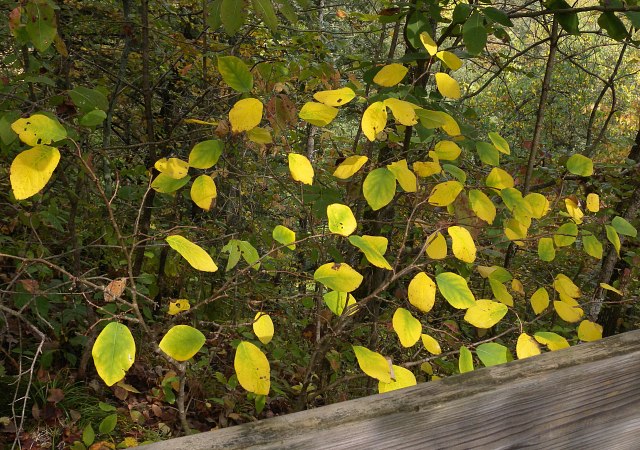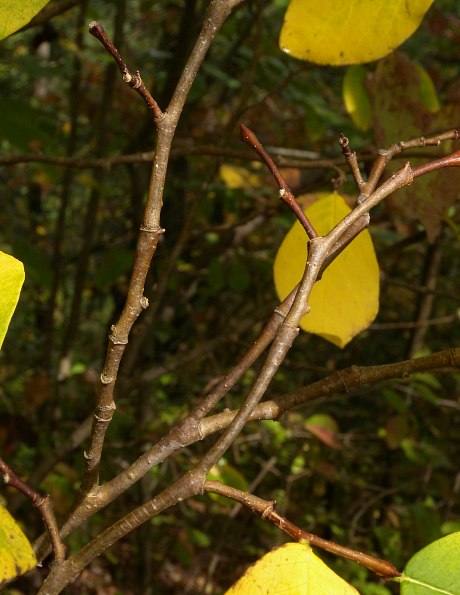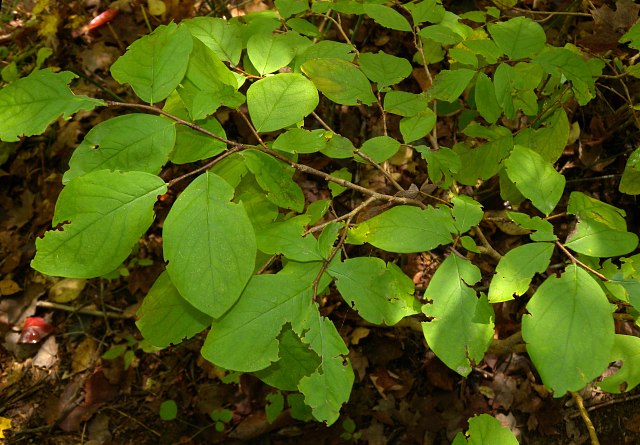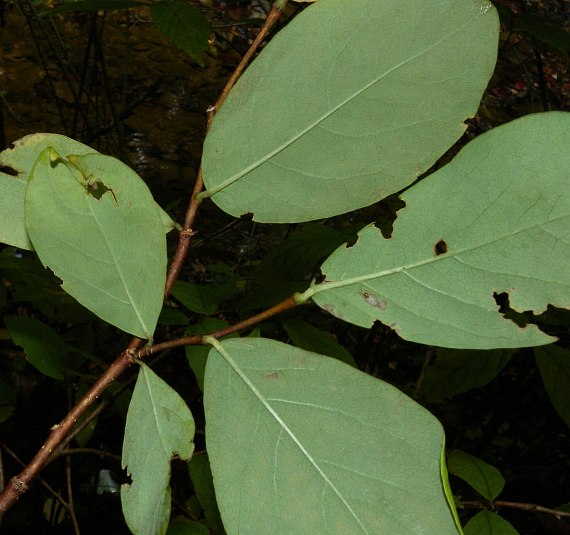
Each flower is about 1/3" (8 mm.) in length, consisting of a pale yellow calyx, no petals, 8 exserted stamens, and an ovary with a strongly exserted slender style. The corolla-like calyx is tubular at its base, but it becomes slightly wider and bell-shaped (campanulate) at its mouth. The margin around the mouth of the calyx is slightly undulate. The anthers of the stamens are yellow, while their filaments are white. The pedicels of the flowers are very short (1-4 mm. in length), light whitish green, and hairless; the peduncles from which the pedicels develop are also short (3-6 mm. in length), light whitish green, and hairless. Both the pedicels and peduncles become somewhat longer when they bear drupes. The blooming period occurs during mid-spring for 1-2 weeks. In the absence of insect pollination, the flowers are self-fertile. Afterwards, they are replaced by one-seeded fleshy drupes that are 8-12 mm. long, ovoid-ellipsoid in shape, and hairless. The drupes ripen during late spring; they vary in color from yellowish green to red at maturity. In addition to gravity, the drupes sometimes spread to new areas by water as they are capable of floating on the surface of water for a few days (Ward & Horn, 1998). The seeds of the drupes are dark brown. The root system is woody. The deciduous leaves become greenish yellow to yellow during autumn.

Cultivation: The preference is partial sun to medium shade, moist to mesic conditions, and a slightly to moderately acidic soil containing loam, sandy loam, or rocky loam. This shrub is slow-growing and it can be long-lived.
Range & Habitat: The native Eastern Leatherwood (Dirca palustris) is an uncommon shrub that occurs in scattered areas across Illinois, although it is slightly more abundant in the central and northern sections of the state as compared to the southern section of the state (see Distribution Map). Populations of this conservative shrub have probably declined throughout the entire state as a result of habitat destruction. It is widely distributed in the eastern half of the USA and adjacent provinces of Canada. Within this area, Eastern Leatherwood is least common along the coastal plain area of southeastern USA. In Illinois and neighboring states, habitats include rich mesic woodlands, floodplain woodlands along streams and creeks, lower areas of wooded slopes in valleys, shaded rocky terraces and ledges along streams and creeks, rocky upland woodlands, and thinly wooded sandstone ridges. This shrub is found in high quality natural areas.

Faunal Associations: Robertson (1929) observed primarily small to medium-sized bees visiting the flowers for nectar and perhaps pollen. These floral visitors include little carpenter bees (Ceratina spp.), cuckoo bees (Nomada cuneata), mason bees (Osmia lignaria), Halictid bees (Augochlora pura, Lasioglossum spp.), plasterer bees (Colletes inaequalis), and Andrenid bees (Andrena rugosa). Robertson also observed a butterfly, Nymphalis antiopa (Mourning Cloak), sucking nectar from the flowers. A small number of insects have been observed to feed destructively on the foliage and bark of Eastern Leatherwood (Dirca palustris). These insect feeders include the leaf-mining larvae of a monophagous or oligophagous moth, Leucanthiza dircella, and such polyphagous insects as Chaetocnema minuta (Minute Flea Beetle), Chionaspis lintneri (Lintner Scurfy Scale), Lepidosaphes ulmi (Oystershell Scale), and the larvae of a moth, Harrisimemna trisignata (Harris' Three-spot); see Needham et al. (1928), Clark et al. (2004), the website of ScaleNet (2014), and the website of the Natural History Museum (2010). It has been surmised that the fruits of Eastern Leatherwood are dispersed by frugivorous birds and mammals, but observations that verify this are currently lacking (Ward & Horn, 1998). The foliage and especially the bark are known to be toxic to humans, and mammalian herbivores, such as deer and rabbits, normally avoid this shrub as a source of food. The fruits are considered mildly narcotic.
Photographic Location: A thinly wooded sandstone ridge and a rocky floodplain woodland near a creek at the Pine Hills State Nature Preserve in west-central Indiana.

Comments: This is one of the less common native woodland shrubs in Illinois. It has attractive foliage and early spring-blooming flowers. The fruits are variably colored and drop from the shrub shortly after they become mature, assuming they are not consumed by birds and small mammals first. This shrub can be identified by its brown jointed twigs; the twigs are swollen where these ring-like joints occur. In addition, the twigs of this shrub are extremely flexible as they can be strongly bent or tied into knots without breaking. No other shrub in Illinois, including willows (Salix spp.), have twigs that are this flexible. Recently, Leatherwood has been divided into two species by some authors (e.g., Yatskievych, 2013): the more eastern Dirca palustris (Eastern Leatherwood) and the more western Dirca decipiens (Midwestern Leatherwood). This latter species is regarded as endemic to Missouri, Arkansas, and Kansas and it has not been reported from Illinois thus far. Midwestern Leatherwood differs from Eastern Leatherwood by having hairy twigs, shorter peduncles and pedicels that are also hairy, and corolla-like calyces that have 4 irregular shallow lobes along their outer margins, instead of being minutely undulate. The fruits of Midwestern Leatherwood are also supposed to have inconspicuous tufts of hairs at their tips, while the fruits of Eastern Leatherwood have hairless tips. Among Amerindians, the tough flexible twigs of Eastern Leatherwood were used for cordage, basketry, and in the construction of thongs.